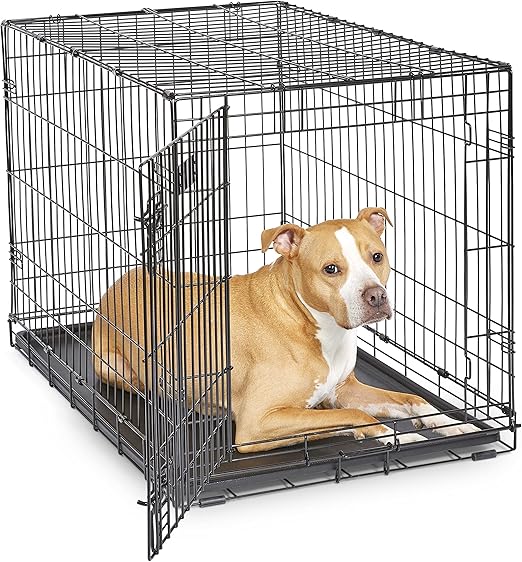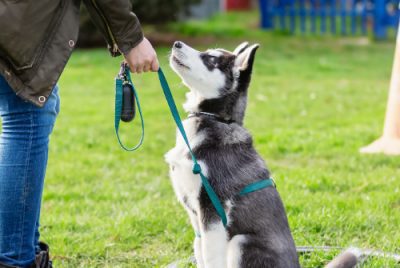Crate Training Your Dog
Post Disclaimer
We may earn a commission for purchases made using our links. Please see our Disclaimer to learn more.
How to Use a Dog Crate the Right Way.
As the dog lover that I am, I understand the importance of finding the best dog crate for training a dog/puppy. A dog crate serves as a haven for your dog, aiding in their development, and providing them with a sense of security. In this article, I will guide you through the factors to consider when choosing a dog crate and recommend some of the best options available.
Importance of Dog Crates for Training
Dog crates play a crucial role in puppy training, offering several benefits for both the dog and the owner. They provide a designated space where the dog can feel secure and comfortable, mimic the natural den-like instinct, and aid in housebreaking. Crates also prevent your dog from engaging in destructive behaviors when unsupervised and help create a routine and structure for their training. Dogs love routines and structure.
Benefits of Crate Training
Security and Comfort: Dogs are den animals by nature, and a crate mimics the secure, cozy environment they seek. Crate training gives your dog a personal space they can retreat to whenever they feel the need for safety or relaxation.
Housebreaking Aid: Crates can be instrumental in housebreaking or potty training. Dogs have an innate desire to keep their sleeping area clean, and using a crate helps puppies develop bladder and bowel control, reducing accidents in the home.
Preventing Destructive Behavior: When left unsupervised, dogs may engage in destructive behaviors, such as chewing on furniture or household items. A crate provides a controlled environment where your dog can be safely confined and prevents them from engaging in destructive behaviors.
Travel and Safety: Crate training makes traveling with your dog more convenient and safer. A familiar crate can reduce anxiety during car rides and prevent your dog from roaming around the vehicle, ensuring their safety and yours.
Potential Drawbacks of Crate Training
While crate training can be beneficial, it is important to acknowledge some potential drawbacks and address them appropriately.
Overuse of Confinement: Excessive use of the crate without providing ample exercise and socialization can lead to feelings of isolation and distress in your dog. It is important to strike a balance and avoid prolonged periods of confinement.
Incorrect Sizing and Introduction: Choosing the wrong-size crate or introducing it too quickly can create a negative association and hinder the training process. The gradual introduction is essential to ensure a positive experience for your dog.
How to Introduce Crate Training
To make crate training a positive and successful experience for your go, follow these steps:
Choosing the Right Crate:
Selecting the appropriate crate size is crucial. Your dog should be able to stand, turn around, and lie down comfortably. Look for a crate that provides enough space for growth but isn’t excessively large. Look for crates that come with a divider to grow with them.
Creating a Positive Association: Make the crate an inviting and positive space by adding a cozy bed, toys, and treats. Encourage your dog to explore the crate voluntarily without any pressure.
Gradual Introduction to the Crate: Start by leaving the crate door open and allow your dog to explore it at their own pace. Use verbal praise and treats to reward any positive interactions with the crate.
Using Treats and Positive Reinforcement: Reward your dog with treats and praise for entering the crate voluntarily or displaying calm behavior inside. Gradually extend the time they spend inside the crate while reinforcing positive associations.
Establishing a Routine: Introduce a consistent routine for crate time, including regular feeding, playtime, and rest time. This helps your dog associate the crate with a predictable schedule and helps to reduce anxiety. Most dogs love a routine.
Ensuring Comfort and Safety: Ensure the crate is placed in a comfortable and secure location within your home. Avoid direct sunlight, drafts, or noisy area that might disturb your dog. Make sure the crate is sturdy and safe with no hazards inside. Remember to check the crate from time to time.
Avoiding Excessive Confinement: While crate training is effective, it is important to avoid excessive confinement. Dogs need regular exercise, mental stimulation, and socialization. Gradually increase the duration of crate time while providing ample opportunities for physical activity and interaction.
Supervision and Monitoring: Always supervise your dog during the crate training process, especially in the initial stages. This allows you to address any signs of distress or discomfort promptly and adjust the training.
Transitioning to Alone Time: Once your dog is comfortable and relaxed in the crate, you can start gradually increasing the duration of alone time. Begin with short intervals and gradually extend the duration, allowing your dog to build confidence and independence.
Troubleshooting Common Challenges
Whining or Barking: If your dog exhibits excessive whining or barking when created, avoid giving in to their demands. Wait for a moment of calmness before opening the crate and reward them for quiet behavior.
Separation Anxiety: Some dogs may experience separation anxiety when initially introduced to the crate. If that happens, try placing a piece of your clothing or a comforting item within the crate. This can sometimes help comfort them with a sense of familiarity and ease their anxiety.
Negative Associations: If your dog shows signs of fear or reluctance towards the crate, take a step back and reintroduce it gradually, using positive reinforcement techniques to build trust and create positive associations.
What to Consider When Choosing a Dog Crate
Size and Growth Potential of the Puppy
When selecting a dog crate, it’s essential to consider the size and growth potential of your puppy. You want a crate that provides enough space for your puppy to stand, turn around, and lie down comfortably. Consider the breed and the expected adult size of your puppy.
Material and Durability
The material and durability of the dog crate are crucial factors to ensure its longevity and effectiveness. Common crate materials include wire, plastic, wood, and fabric. Wire crates offer durability, good ventilation, and visibility. Plastic crates create a cozy den-like environment and are lightweight. Some wood crates are aesthetically pleasing to your home surroundings. Soft-sided crates are portable and suitable for travel. Consider your specific needs and preferences when choosing the material.
Safety Features
The safety of your puppy should be a top priority when selecting a dog crate. Look for crates with secure latches, smooth edges, and sturdy construction. Ensure no sharp parts or potentially hazardous components could harm your puppy.
Portability and Ease of Cleaning
If you plan to travel with your puppy or need to move the crate frequently, consider the portability and ease of cleaning. Look for crates that are lightweight, collapsible, and have handles for easy transportation. Additionally, choose crates with removable trays or easily cleanable materials to maintain hygiene.
Best Dog Crates for Training a Puppy
Now let’s explore some of the best dog crates suitable for training. Keep in mind that the ideal crate will depend on your specific needs, preferences, and your dog’s characteristics.
Wire Crates
Wire crates are popular and versatile options for puppy training. They provide good ventilation, and visibility, and allow your puppy to observe their surroundings. Wire crates often have removable trays, making cleaning a breeze. The open design of wire crates helps reduce any feelings of confinement and promotes better airflow.
 Plastic Crates
Plastic Crates
Plastic crates offer a cozy and den-like environment for your puppy. They provide a sense of security and privacy. Plastic crates are typically lightweight, making them easy to transport. These crates often have a sturdy construction and secure latches, ensuring your puppy’s safety.
 Furniture Crates – Wood
Furniture Crates – Wood
Wood crates can be very aesthetically pleasing to your home. Serving a dual purpose as an end table. They can be coordinated with your home décor.
 Soft-sided Crates
Soft-sided Crates
Soft-sided crates are excellent choices for puppies who are calm and well-behaved. They are lightweight, portable, and easy to assemble. Soft-sided crates are ideal for travel and temporary use. However, they may not be suitable for puppies prone to chewing or those who require more structure during training.
 Heavy-Duty Crates
Heavy-Duty Crates
For puppies with high energy or strong chewing tendencies, heavy-duty crates are a reliable option. These crates are constructed with durable materials, such as reinforced steel, and are designed to withstand determined chewers. Heavy-duty crates provide maximum security and durability for long-term use.
 Travel Crates
Travel Crates
If you frequently travel with your puppy, consider a crate specifically designed for travel. These crates are typically lightweight, easy to assemble, and meet the necessary safety requirements for air or car travel. Look for travel crates with secure locks and proper ventilation to ensure your puppy’s comfort during journeys.
 Play Pens
Play Pens
Something else you may think about later on could be a play pen. Play pens are great if you want to give your dog more room to play. Also, would work great for camping and other excursions. This will not help with potty training since your dog will have to much room and will not hold their bladder.
Crate Training Tips for Puppies
Proper crate training is crucial for a positive and successful experience for both you and your puppy. Here are some helpful tips to assist you in crate training your puppy effectively:
Introduction to the Crate
Introduce the crate gradually, making it a positive and inviting space for your puppy. Start by leaving the crate door open and placing treats or toys inside to encourage exploration.
Making the Crate a Positive Space
Associate the crate with positive experiences. Offer meals and treats inside the crate and praise your puppy when they voluntarily enter. Make the crate comfortable with cozy bedding or blankets.
Gradual Introduction and Extending Crate Time
Initially, allow your puppy to spend short periods in the crate and gradually increase the duration. This helps them become accustomed to being alone and reduces anxiety. Always ensure your puppy has had sufficient exercise and bathroom breaks before crating.
Crate Training Schedule
Establish a consistent crate training schedule. Set specific times for crate sessions, including nap times, quiet time, and overnight sleep. Consistency helps your puppy understand the routine and promotes successful training.
Using Treats and Positive Reinforcement
Reward your puppy with treats and praise when they enter the crate willingly or displays calm behavior inside. Positive reinforcement helps create positive associations with the crate.
FAQs (Frequently Asked Questions)
Can I use a crate for potty training my puppy? Yes, crates are useful for potty training as they encourage puppies to control their bladder and bowel movements.
Can I crate-train an older dog? Yes, crate training can be effective for older dogs as well. Follow the same steps but be mindful of any physical limitations or medical conditions that may require adjustments to the training process.
How long can I leave my puppy in a crate? Puppies should not be crated for extended periods. As a general guideline, puppies can hold their bladder for approximately one hour per month of age, up to a maximum of about 8 hours.
Are soft-sided crates suitable for all dogs? Soft-sided crates are best for calm and well-behaved dogs/puppies. Active or chew-prone dogs/puppies may require a sturdier option.
Should I cover the crate with a blanket or leave it open? It depends on your dog’s preference. Some dogs/puppies may feel more secure with a covered crate, while others may prefer it open for better visibility.
Can I use the crate as a punishment for my dog/puppy? No, the crate should never be used as a form of punishment. It should always be associated with positive experiences and a safe space for your puppy.
Remember, crate training is a gradual process, and each dog is unique. Be patient, loving, and
Conclusion
Crate training, when done correctly, can be a useful tool in dog training. It offers numerous benefits such as providing a safe space aiding in housebreaking and preventing destructive behaviors. However, it is crucial to approach crate training with patience, love, understanding, and respect for your dog’s individual needs. By following my suggestions and addressing any challenges that arise, you can help your furry friend become comfortable and content in their crate. With patience, positive reinforcement, and a suitable crate, your dog will thrive in their training journey. You will eventually learn that your dog loves their crate.




 Furniture Crates – Wood
Furniture Crates – Wood






Comments are closed.